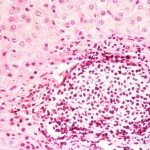Link to Pubmed [PMID] – 15793797
Hepatology 2005 May;41(5):986-94
Only humans and chimpanzees are fully permissive for replication of hepatitis C virus (HCV), an important cause of liver cirrhosis and cancer worldwide. The absence of suitable animal models limits opportunities for in vivo evaluation of candidate hepatitis C therapeutics and slows progress in the field. Here, we describe a chimeric virus derived from GB virus B (GBV-B), an unclassified hepatotropic member of the family Flaviviridae that is closely related to HCV and infects tamarins (Saguinus sp.), in which a functionally important HCV regulatory sequence replaced an analogous sequence in the 5′ nontranslated region (5’NTR) of the GBV-B genome. The transplanted sequence comprised domain III of the internal ribosome entry site (IRES), which directly binds the 40S ribosome subunit and is a target for candidate therapeutics. The chimeric 5’NTR retained ribosome binding activity and was competent in directing protein translation both in cell-free translation reactions and in transfected primary tamarin hepatocyte cultures. Virus rescued from the chimeric RNA replicated in the liver of tamarins, causing biochemical and histopathological changes typical of viral hepatitis. However, adaptive mutations were required elsewhere in the genome for efficient replication. Virus was not rescued from other, translationally competent, chimeric RNAs in which domain II of the IRES was exchanged. Thus, the 5’NTR appears to contain virus-specific replication signals that interact with other sites within the viral genome or with viral proteins. In conclusion, such novel chimeric flaviviruses offer opportunities for new insights into HCV replication mechanisms, while potentially facilitating the evaluation of candidate therapeutics in vivo.

